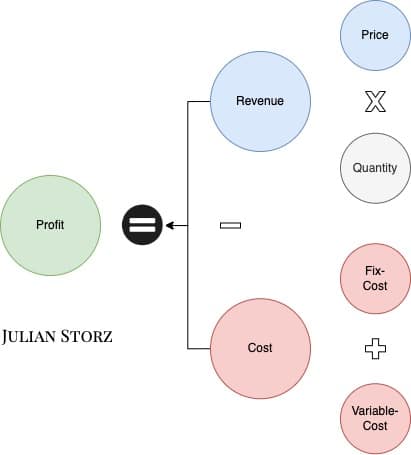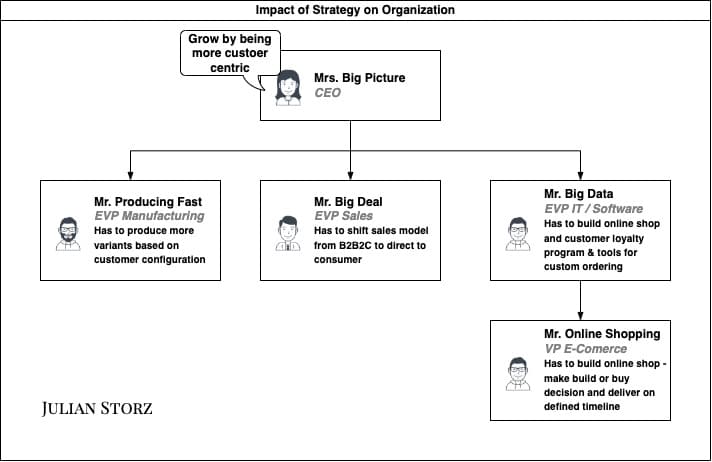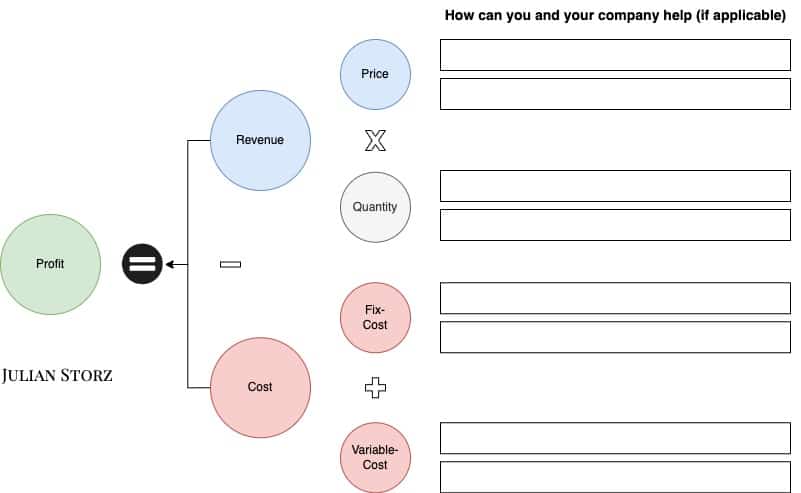At MongoDB I have been responsible for a German Car Manufacturer and the Robert Bosch Group. I am very grateful for having given this opportunity, as I did not have direct sales experience (other than pre-sales) before taking over these customers. What I did have though, was entrepreneurial experience, management consulting skill set and technical understanding which ultimately allowed me to help my customer to massively adapt the technology and turn Bosch into a strategic customer with a dedicated team.
My philosophy about sales and pretty much anything in life is structure follows strategy. So before starting to execute, it is critical to deeply understand what you actually want to achieve. Once you know your goals, it is all about operating rhythm and time management to ensure what truly matters gets done.
[Link Time Management Article]
Why a strategy matters
Personally, I’ve often overlooked the significance of a mission statement in rallying people around a common objective. Particularly in our day-to-day roles in sales, it’s easy to assume that everyone shares your level of motivation and clarity regarding goals. However, the reality is that most individuals are juggling multiple tasks, projects, and personal commitments. The same holds true for management, who are typically immersed in various responsibilities, from client interactions to internal processes and organizational growth endeavors.
Therefore, succinctly articulating your objectives becomes paramount. Providing a clear direction enables those around you to engage in meaningful discussions and align their efforts effectively. Even if your detailed plan spans 30 pages, your overarching vision must be encapsulated in one to two pages at most. Time constraints mean that people need to swiftly grasp the essence of your vision, feel motivated, aligned, and assured that you’ve meticulously considered the path forward.
In essence, a mission statement offers a top-down perspective on your business, serving as both a rationale for investing time and resources and a concise roadmap for achieving success.

A strategy provides you a path – shielding you from distractions – it is still going to be difficult, but you know where you are heading
How to build an account strategy
A clear strategy comprises several key components:
- Estimation of Total Potential: Understanding the overall potential of your market or target audience.
- Estimation of Potential for the Next 3 Years/1 Year: Forecasting the growth or potential within a specific timeframe to guide strategic planning.
- SMART Goals: Setting objectives that are Specific, Measurable, Accepted, Realistic, and Terminated within a defined period. These goals provide clarity and accountability.
- Milestones for the Next 12 Months: Establishing tangible checkpoints or achievements necessary to reach the defined potential. These milestones serve as markers of progress and help maintain focus.
- Clear Guide Rails: Outlining the guiding principles or boundaries that shape the journey toward the set goals. These guide rails define the “what” of the strategy without delving into the specifics of “how.”
To facilitate this strategic process, I’ll lead you through a step-by-step approach to:
- Collecting necessary data: Gathering relevant information to inform decision-making and goal-setting.
- Gaining insights into customers’ goals: Understanding the objectives and priorities of your target audience.
- Aligning with customer goals: Ensuring that your strategy is aligned with the needs and aspirations of your customers.
- Setting priorities based on alignment: Establishing the most critical areas of focus and action items based on the alignment with customer goals.
Make a Wallet / Revenue Potential estimation and set a clear goal
In business, every endeavor aims to maximize returns on invested time. Therefore, before committing significant resources to a venture, it’s essential to estimate your customer’s revenue potential (often referred to as wallet) and determine the achievable share of that potential in the near future (wallet share).
Making a wallet estimation
Breaking down the estimation of total potential into components can provide clarity. Revenue potential can be calculated as the price per unit multiplied by the number of units you can sell. Here are some examples:
- For HR Software licensed by the number of users:
- Price: License cost per user, factoring in discounts for larger orders.
- Quantity: Number of HR employees, considering the percentage using your software.
- For Database technology licensed by cores:
- Price: License cost per core, with discounts for bulk orders.
- Quantity: Total applications a customer of this size typically runs, considering your technology’s usage percentage.
- For Machines in a production facility:
- Price per machine.
- Quantity: Number of factories multiplied by machines per factory.
- For Travel Software commission per Euro spent:
- Price: Commission charged.
- Quantity: Total travel budget of the company.

Review customer strategy
Once you’ve identified a customer with significant growth potential, it’s time to devise the right approach for engaging with the organization. Understanding the trajectory of the organization is paramount to relevance. Delve into their annual reports, press releases, and engage with their C-Suite through podcasts and event interviews. Key areas to focus on include:
Corporate-Level Objectives:
Determine the priorities of the executive leadership. Examples include:
- Reducing carbon footprint.
- Increasing revenue.
Business Strategy:
Explore the guidelines provided by executives to achieve these objectives. For instance:
- Lowering carbon footprint by 10% through renewable energies.
- Direct-to-consumer sales to enhance customer insights.
Business Initiatives:
Identify the actions taken to realize strategic goals. For example:
- Implementing solar roofs across all factories.
- Establishing an online shop and a customer loyalty program.
Current Challenges:
Understand the obstacles hindering the defined initiatives. Such as:
- Decision-making on panels, economic viability, and maintenance.
- Choosing between self-development or purchase of software, prioritization for rapid impact.
Critical Capabilities:
Determine the resources needed to overcome these obstacles. Such as:
- Partnering for ROI estimation and provision of products and services.
- Accessing software developers, databases, compute resources, and networking support.
This structure allows you to grasp the customer’s priorities, challenges, and strategies across different components.
Understand the impact of strategy on customer economics
In theory, for-profit companies consistently pursue their core objective: profit maximization. Every decision, even indirectly, is tied to this goal. However, in reality, political and social factors also influence organizational decision-making, often interconnected with economic factors.
Consider a company transitioning to green energy. This shift may stem from market demands for lower CO2 emissions due to increasing CO2 taxation or changing customer preferences. Consequently, this could impact variable costs, sales quantities, or necessitate price adjustments to offset additional expenses, potentially affecting demand.
Similarly, a company aiming to establish a direct-to-consumer relationship seeks to boost sales volumes, secure upsells, and reduce variable costs by trimming marketing and channel expenses.
It’s important to recognize that companies inherently prioritize profit maximization; otherwise, they would operate in the non-profit sector. Therefore, when engaging with customers, it’s essential to assess how their strategies impact both the top and bottom lines.

Profitability Tree: Profit = Revenue – Cost
Map customer strategy on customer organization
Once you’ve grasped your customers’ priorities and their business model, it’s essential to analyze their organizational structure. This step is crucial because various parts of the organization are affected differently by the strategic initiatives you’ve identified. The CEO and board typically delineate their goals and allocate specific objectives to divisional presidents to execute their vision. Therefore, it’s vital to consider whom to target with your business proposals.

Answer yourself the following questions and research if you can find any details about it online, in articles, interviews etc.
- For each department understand:
- Which of the strategic goals are connected
- What are the initiatives undertaken for this particular organizational unit
- What are the individual KPIs related to these strategies
- Sales
- Deliver more net new customers
- Increase prices
- Manufacturing
- Produce more
- Reduce costs
- Reduce carbon emissions
- Diversify supply chain and risk
- IT
- …
- Sales
How can your product or service impact core KPIs
Once you’ve gained a comprehensive understanding of your customer’s needs and goals, you can craft a clear value proposition based on your product’s capabilities. Clearly articulate where your product offers an advantage, whether it’s on the cost or revenue side, and demonstrate how this aligns with the individual KPIs of your customer’s strategy.
As this process is highly dependent on your specific product or service, it can be challenging to generalize. To guide your approach, I recommend referring to the Profitability Tree provided earlier and reflecting on the measurable outcomes achieved with past customers. Consider how these outcomes can be mapped to the goals of your current customer, providing tangible evidence of the value your product can deliver.

Identify key personas and projects
Keep in mind that various levels of hierarchy within an organization prioritize different aspects. To effectively sell your solution, you’ll need support from executives who influence buying decisions, as well as individuals who directly benefit from your solution.
Map out clearly which stakeholders in the organization stand to benefit from your solution and how. Once you have a clear understanding of this, you’ll be well-prepared to execute your sales campaign and deliver a compelling message that resonates with your customers, ultimately leaving a lasting impression.
Bring it all together – Exemplary Agenda for an account plan
- Total Revenue Potential of customer
- How did you come up with the numbers
- What are the assumptions taken
- What is the customer’s strategy
- How does this strategy affect the different organization units
- What are the business units’ main priorities / programs to achieve strategic goals
- How are they measured
- What is their main driver?
- Revenue
- Cost
- What are the business units’ main priorities / programs to achieve strategic goals
- How can you help these initiatives
- What KPIs can you impact?
- What should you focus on
- Who are the key stakeholders benefiting from your product and solution and what are the individual benefits of working with you
- Executives
- Middle Management
- Operational employees
- What are the main milestones you want to work on, in what order to get the targeted revenue from your customer, and include necessary actions into your action plan / operating rhythm [Link Operating Rhythm / Time Management Article]
How to execute?
Find more on Pipeline Generation here:
Find more about Time Management here:
Looking for a place to learn and grow your career?
Please sign up to my Newsletter or contact me directly, I am either hiring myself or know people who are, and I am happy to chat.